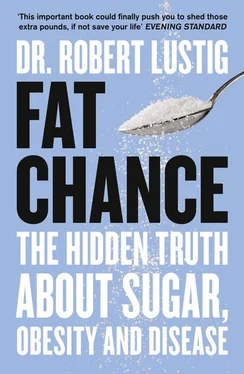The United Kingdom, Australia, and Canada are right behind us. Also, in the past ten years, obese children have increased in France from 5 to 10 percent, in Japan from 6 to 12 percent, and in South Korea from 7 to 18 percent. [16] S. Yoo et al., “Obesity in Korean Pre-Adolescent School Children: Comparison of Various Anthropometric Measurements Based on Bioelectrical Impedance Analysis,” Int. J. Obes. 30 (2006): 1086–90.
In fact, obesity and chronic metabolic diseases are occurring in underdeveloped countries that have never had such problems before. [17] N. Gupta et al., “Childhood Obesity in Developing Countries: Epidemiology, Determinants, and Prevention,” Endocr. Rev. 33 (2012): 48–70.
Previously, poorer countries such as Malaysia had problems with malnutrition. Now Malaysia has the highest prevalence of type 2 diabetes on the planet. China has an epidemic of childhood obesity, at 8 percent in urban areas. Brazil’s rate of increase in obesity is predicted to reach that of the United States by 2020. Even India, which continues to have an enormous problem with malnutrition, is not immune – since 2004, the number of overweight children increased from 17 percent to 27 percent. Sienna is not a rarity; her obese peers are being born everywhere. The areas experiencing the greatest rise in obesity and type 2 diabetes include Asia (especially the Pacific Rim) and Africa, which are not wealthy areas. [18] A. Ramachandran et al., “Diabetes in Asia,” Lancet 375 (2010): 408–18.
No corner of the globe is spared.
This is not an American problem, an Australian problem, a British problem, or a Japanese problem. This is a global problem. Could each of these countries be experiencing the same cultural shifts toward gluttony and sloth that we are? Childhood obesity knows no intellect, class, or continent.
Конец ознакомительного фрагмента.
Текст предоставлен ООО «ЛитРес».
Прочитайте эту книгу целиком, купив полную легальную версию на ЛитРес.
Безопасно оплатить книгу можно банковской картой Visa, MasterCard, Maestro, со счета мобильного телефона, с платежного терминала, в салоне МТС или Связной, через PayPal, WebMoney, Яндекс.Деньги, QIWI Кошелек, бонусными картами или другим удобным Вам способом.
J. Kim et al., “Trends in Overweight from 1980 Through 2001 Among Preschool-Aged Children Enrolled in a Health Maintenance Organization,” Obesity 14 (2006): 1164–71.
S. J. Olshansky et al., “A Potential Decline in Life Expectancy in the United States in the 21st Century,” New Engl. J. Med. 352 (2005): 1138–45.
World Health Organization, Fact Sheet: Obesity and Overweight (2011), www.who.int/mediacentre/factsheets/fs311/en/.
UN General Assembly, “Prevention and Control of Non-Communicable Diseases,” New York, 2010.
J. M. Chan et al., “Obesity, Fat Distribution, and Weight Gain as Risk Factors for Clinical Diabetes in Men,” Diabetes Care 17 (1994): 961–69.
S. L. Gortmaker et al., “Changing the Future of Obesity: Science, Policy, and Action,” Lancet 378 (2011): 838–47.
K. C. Sung et al., “Interrelationship Between Fatty Liver and Insulin Resistance in the Development of Type 2 Diabetes,” J. Clin. Endocrinol. Metab. 96 (2011): 1093–97.
S. L. Gortmaker et al., “Changing the Future of Obesity: Science, Policy, and Action,” Lancet 378 (2011) 838–47.
R. Padwal et al., “Long-Term Pharmacotherapy for Obesity and Overweight,” Cochrane Database Syst. Rev., Art. No.: CD004094. DOI: 10.1002/14651858 (2004). PMID: 15266516.
C. B. Newgard et al., “A Branched-Chain Amino Acid-Related Metabolic Signature That Differentiates Obese and Lean Humans and Contributes to Insulin Resistance,” Cell Metab. 9 (2009): 311–26.
P. Chanmugam et al., “Did Fat Intake in the United States Really Decline Between 1989–1991 and 1994–1996?” J. Am. Diet. Assoc. 103 (2003): 867–72.
D. Thompson et al., “Lifetime Health and Economic Consequences of Obesity,” Arch. Int. Med. 159 (1999): 2177–83.
J. Bhattacharya et al., “Who Pays for Obesity?” J. Econ. Perspect. 25 (2011): 139–58.
J. B. Schwimmer et al., “Health-Related Quality of Life of Severely Obese Children and Adolescents,” JAMA 289 (2003): 1813–19.
T. A. Wadden et al., “Treatment of Obesity by Very Low Calorie Diet, Behavior Therapy, and Their Combination: A Five-Year Perspective,” Int. J. Obes. 13 (1989): 39–46; M. W. Schwartz et al., “Regulation of Body Adiposity and the Problem of Obesity,” Arterioscler. Thromb. Vasc. Biol. 17 (1997): 233–38.
S. Yoo et al., “Obesity in Korean Pre-Adolescent School Children: Comparison of Various Anthropometric Measurements Based on Bioelectrical Impedance Analysis,” Int. J. Obes. 30 (2006): 1086–90.
N. Gupta et al., “Childhood Obesity in Developing Countries: Epidemiology, Determinants, and Prevention,” Endocr. Rev. 33 (2012): 48–70.
A. Ramachandran et al., “Diabetes in Asia,” Lancet 375 (2010): 408–18.












